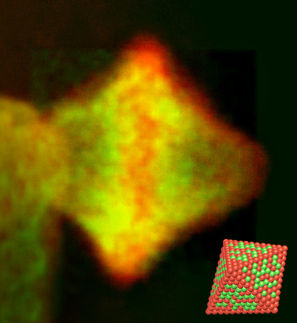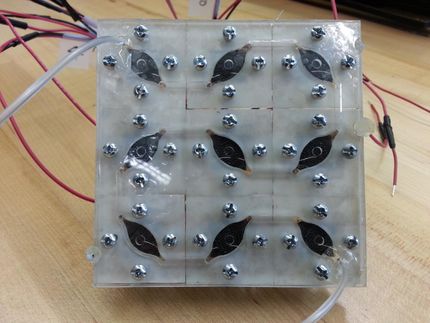Solar cell directly splits water for hydrogen
Plants trees and algae do it. Even some bacteria and moss do it, but scientists have had a difficult time developing methods to turn sunlight into useful fuel. Now, Penn State researchers have a proof-of-concept device that can split water and produce recoverable hydrogen.
"This is a proof-of-concept system that is very inefficient. But ultimately, catalytic systems with 10 to 15 percent solar conversion efficiency might be achievable," says Thomas E. Mallouk, the DuPont Professor of Materials Chemistry and Physics. "If this could be realized, water photolysis would provide a clean source of hydrogen fuel from water and sunlight."
Although solar cells can now produce electricity from visible light at efficiencies of greater than 10 percent, solar hydrogen cells - like those developed by Craig Grimes, professor of electrical engineering at Penn State - have been limited by the poor spectral response of the semiconductors used. In principle, molecular light absorbers can use more of the visible spectrum in a process that is mimetic of natural photosynthesis. Photosynthesis uses chlorophyll and other dye molecules to absorb visible light.
So far, experiments with natural and synthetic dye molecules have produced either hydrogen or oxygen-using chemicals consumed in the process, but have not yet created an ongoing, continuous process. Those processes also generally would cost more than splitting water with electricity. One reason for the difficulty is that once produced, hydrogen and oxygen easily recombine. The catalysts that have been used to study the oxygen and hydrogen half-reactions are also good catalysts for the recombination reaction.
Mallouk and W. Justin Youngblood, postdoctoral fellow in chemistry, together with collaborators at Arizona State University, developed a catalyst system that, combined with a dye, can mimic the electron transfer and water oxidation processes that occur in plants during photosynthesis. The key to their process is a tiny complex of molecules with a center catalyst of iridium oxide molecules surrounded by orange-red dye molecules. These clusters are about 2 nanometers in diameter with the catalyst and dye components approximately the same size. The researchers chose orange-red dye because it absorbs sunlight in the blue range, which has the most energy. The dye used has also been thoroughly studied in previous artificial photosynthesis experiments.
They space the dye molecules around the center core leaving surface area on the catalyst for the reaction. When visible light strikes the dye, the energy excites electrons in the dye, which, with the help of the catalyst, can split the water molecule, creating free oxygen.
"Each surface iridium atom can cycle through the water oxidation reaction about 50 times per second," says Mallouk. "That is about three orders of magnitude faster than the next best synthetic catalysts, and comparable to the turnover rate of Photosystem II in green plant photosynthesis."
The researchers impregnated a titanium dioxide electrode with the catalyst complex for the anode and used a platinum cathode. They immersed the electrodes in a salt solution, but separated them from each other to avoid the problem of the hydrogen and oxygen recombining. Light need only shine on the dye-sensitized titanium dioxide anode for the system to work. This type of cell is similar to those that produce electricity, but the addition of the catalyst allows the reaction to split the water into its component gases.
The water splitting requires 1.23 volts, and the current experimental configuration cannot quite achieve that level so the researchers add about 0.3 volts from an outside source. Their current system achieves an efficiency of about 0.3 percent.
"Nature is only 1 to 3 percent efficient with photosynthesis," says Mallouk. "Which is why you can not expect the clippings from your lawn to power your house and your car. We would like not to have to use all the land area that is used for agriculture to get the energy we need from solar cells."
Other news from the department science
Most read news
More news from our other portals
See the theme worlds for related content
Topic world Synthesis
Chemical synthesis is at the heart of modern chemistry and enables the targeted production of molecules with specific properties. By combining starting materials in defined reaction conditions, chemists can create a wide range of compounds, from simple molecules to complex active ingredients.

Topic world Synthesis
Chemical synthesis is at the heart of modern chemistry and enables the targeted production of molecules with specific properties. By combining starting materials in defined reaction conditions, chemists can create a wide range of compounds, from simple molecules to complex active ingredients.





















































